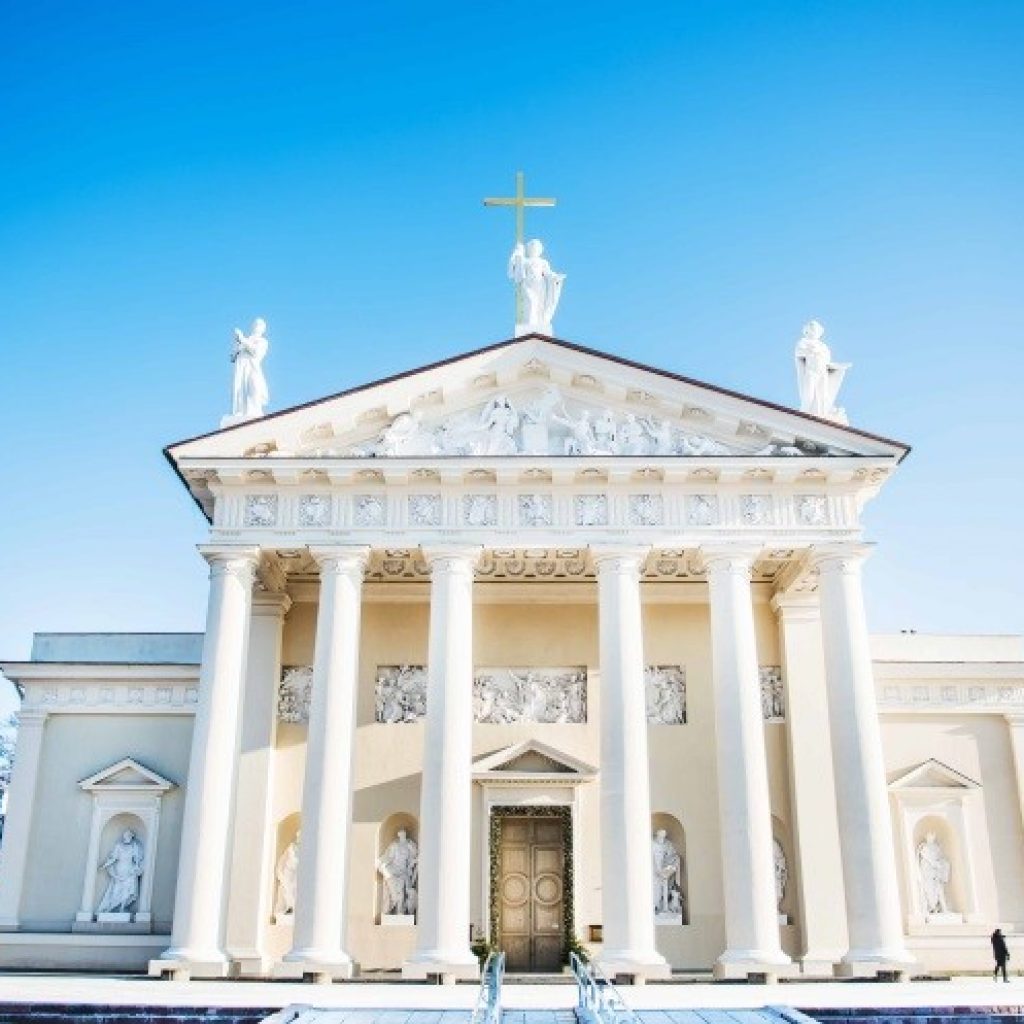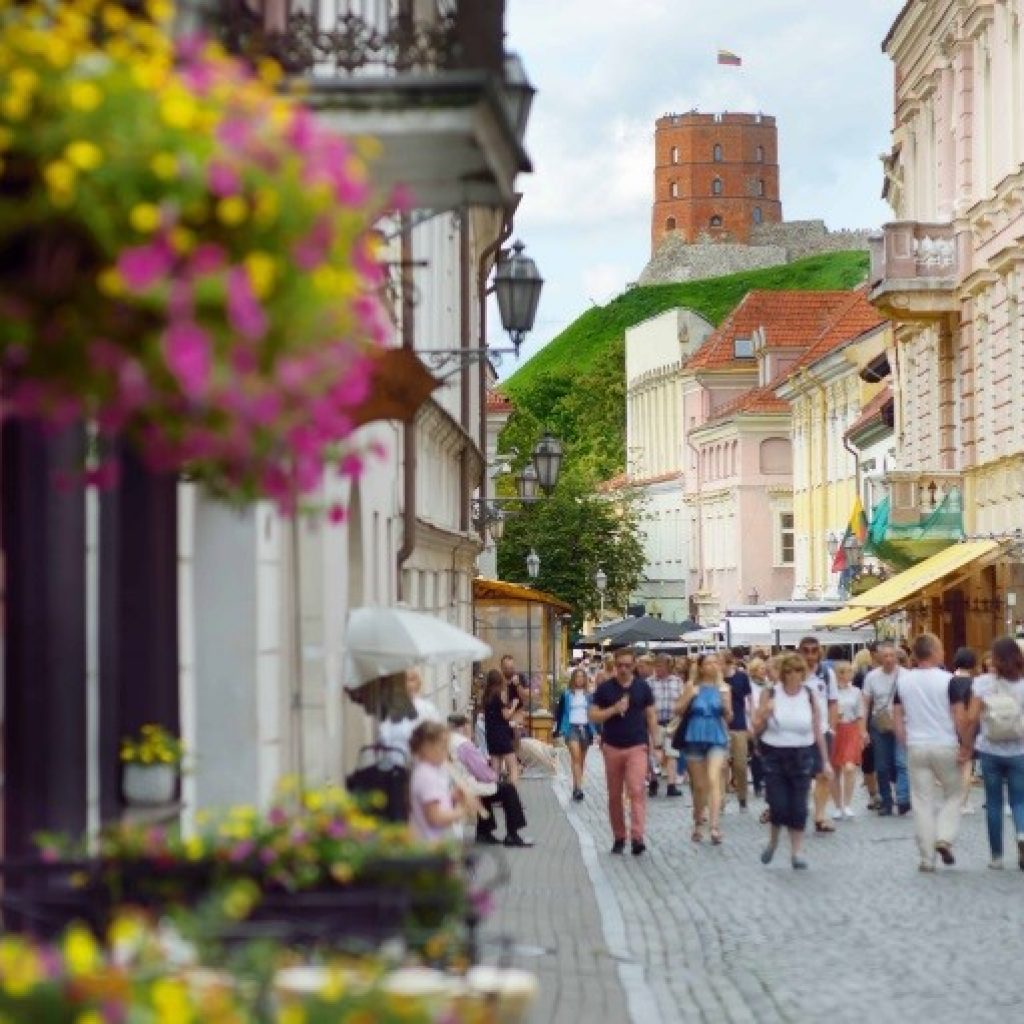Here we present you – in no particular order – the best that Vilnius has to offer in terms of city‘s history and architecture. These places are definitely a must see – and almost everything is within a walking distance right in the fabled Vilnius‘ old town. Strap in and let‘s go exploring!
Vilnius University

Parts of the Vilnius university architectural ensemble – Church of Sts. Johns and its bell tower
@GO Vilnius
Vilnius university is one of the oldest universities in Central Europe, it was founded in 1579 by Catholic monks – Jesuits. Vilnius university boasts 13 internal courtyards, arcades and galleries. The oldest campus is home to three faculties – history, philology and pshilosophy. The campuses of VU all feature Gothic, Baroque and Classical styles of architecture. The main Library, which was built in 1570 holds one of two existing copies of the first ever book printed in Lithuanian, The Simple Words of Catechism, which was written by Martynas Mažvydas . You can also get an exclusive panoramic view of Vilnius from the campanile of St. John‘s Chruch.
Gates of Dawn

@GO Vilnius
Gates of Dawn is one of the most visited shrines in Vilnius and the last remaining gate of the first original five gates of the city wall, that were built at the beginning of the 16th century. It is also one of Lithuania‘s most important religious, historical and cultural monuments. The painting of the Blessed Virgin Mary, Mother of Mercy in the Chapel of the Gates of Dawn is known all over the world and is said to have miracle-working powers. The Holy Mother of God of the Gates of Dawn has been granted the tittle of Mother of Mercy twice.
Church of St. Anne

@GO Vilnius
The Chruch of St. Anne is a masterpiece of the late Gothic period, but there is no consensus about its originator or period of construction. Popular legend has it that Napoleon Bonaparte was fascinated by the splendor and beauty of the church and wanted to take it back to Paris in the palm of his hand. St. Annes church has survived to the present day for over 500 years and has become an undeniable symbol of the city.
Vilnius Town Hall

@GO Vilnius
In 1387, as Vilnius gained Magdeburg rights, there appeared a need for headquarters for the city authorities. As the main square of the city was already located here, it was decided to build the Town Hall in the same place. The Town Hall was built in the gothic style in the beginning, but was later reconstructed and turned into a Classical building. In its history, it was transformed into a city theatre and later into an art museum. Today Vilnius Town Hall is a representative building, whose pediment is adorned with the coat-of-arms of the city of Vilnius – St Christopher carrying baby Jesus on his shoulders.
Cathedral Basilica

@GO Vilnius
The Cathedral of St. Stanislav and St. Vladislav is the most important place of worship for Lithuania’s Catholics, and the venue for the country’s main Christian and national festivities. It was granted the name of ‘Basilica’ by Pope Pius XI. Many of Lithuania’s key historical figures are buried in the Sovereigns’ Mausoleum, which is located beneath the chapel of St. Casimir, such as Vytautas the Great, the Grand Duke of Lithuania and King Alexander of Poland. The cathedral’s original temple dates back to between the 13th or 15th century.
Palace of the Grand Dukes of Lithuania

@GO Vilnius
The reconstructed Palace of the Grand Dukes of Lithuania, the former political, diplomatic, cultural center of the State, was one of the most famous in Europe in the 15th-17th centuries, and was originally constructed for the rulers of the Grand Duchy of Lithuania and the future Kings of Poland. It is excellently located right in the heart of Vilnius within the confines of Lower castle. Part of the reconstructed Palace of the Grand Dukes in Vilnius Lower Castle officially transferred to the museum. In the museum there are four exhibition tour routes directly related to the historical functions of this residence.
Gediminas Tower of the Upper Castle

@GO Vilnius
Gediminas’ Tower is an important state and historic symbol of the city of Vilnius and Lithuania itself. The three-floor tower was rebuilt in 1933 and some remnants of the old castle have been restored, guided by archaeological research. Legend has it that Duke Gediminas had a dream that up on a hill stood a great wolf made of iron, and it was howling as loudly as if it were a hundred wolves. The dream was interpreted as an omen, indicating that Gediminas should build a city in this place, which would later become known around the world and would become the magnificent capital city of Lithuania. Gediminas castle is the only surviving part of that castle built by Gediminas.
Užupis

@GO Vilnius
Užupis is a self-proclaimed republic, largely located in Vilnius‘ Old Town and an UNESCO World Heritage Site. It is a Bohemian and artistic district and has its own anthem, constitution, president, bishop, two churches and its own guardian called The Bronze Angel of Užupis. The district has been popular with artists for some time, and has been compared to Montmartre in Paris and to Freetown Christiania in Copenhagen. Užupis means „beyond the river“ in the Lithuanian language and refers to the Vilnia River.
Museum of Occupations and Freedom Fights

@GO Vilnius
The Museum of Genocide Victims is arguably the darkest in Vilnius. The museum if dedicated mostly to collecting and exhibiting documents relating to the 50-year occupation of Lithuania by the Soviet Union, the anti-Soviet Lithuanian partisans, and the victims of the arrests, deportations and executions that took place during this period. The museum is divided into two parts – the upper two floors document the Lithuanian partisans’ resistance against the Soviet occupiers, the deportations of Lithuanians to Siberia and day-to-day life in the LTSR. The other part of the museum are the prison cells, and execution and torture chambers in the basement.Chillingly, the cells are exactly how the KGB officers left them upon leaving Lithuania in 1991.
Pilies Street

@GO Vilnius
Pilies street – literally “Castle Street”, is one of the main streets in the Old Town of Vilnius. Pilies street can offer an architectural variety: you can find gothic, renaissance and baroque style buildings right next to each other. The street appeared in the place of the former road from Vilnius Castle to the south, towards Poland and Russia. Kings, noblemen and legates of the Pope passed Pilies street on the way to the castle. A beautiful view of Gediminas Tower can be seen from Pilies Street.




Customer
common application essay help
Top 10 places to see in Vilnius – feelZcity
Customer
tadalafil pulmonary arterial hypertension
Top 10 places to see in Vilnius – feelZcity
Customer
Viagra uk https://500px.com/p/arrameru/?view=groups
Kudos! I enjoy this.
Customer
Viagra reviews https://pinshape.com/users/2612491-medicine-online-order
Seriously all kinds of helpful information.
Customer
canadian pharmacy meds https://www.viki.com/users/canadianpharmaciess/about
Fantastic write ups. Many thanks!
Customer
canadian rx http://climbingcoaches.co.uk/member-home/londondrugscanada/profile/
You actually expressed it fantastically.
Customer
Interactions for viagra https://fliphtml5.com/homepage/fhrha
Many thanks! Fantastic information!
Customer
canadian discount pharmacies https://sketchfab.com/canadianpharmaceuticalsonline
Wonderful forum posts. Many thanks!
Customer
Viagra for sale https://datastudio.google.com/reporting/1e2ea892-3f18-4459-932e-6fcd458f5505/page/MCR7C
Thank you. Good stuff.
Customer
Viagra generic http://canadianpharmaceuticalsonlinee.iwopop.com/
Nicely put. Cheers.
Customer
canadian pharcharmy online https://canadianpharmaceuticalsonline.gger.jp/archives/18015248.html
Very good postings. Kudos.
Customer
canada pharmacies https://calendly.com/canadianpharmaceuticalsonline/onlinepharmacy
Valuable tips. Many thanks.
Customer
Viagra reviews https://sanangelolive.com/members/girsagerea
Nicely put. Thanks.
Customer
Buy viagra https://sanangelolive.com/members/canadianpharmaceuticalsonlineusa
Cheers! Loads of stuff!
Customer
northwest pharmacies https://network.myscrs.org/profile/422020/0
Whoa a good deal of amazing data.
Customer
online drug store https://www.audiologysolutionsnetwork.org/profile/422019/0
Seriously many of useful knowledge.
Customer
Generic for viagra https://moaamein.nacda.com/profile/422018/0
Good info. Appreciate it!
Customer
Viagra rezeptfrei https://legalmarketplace.alanet.org/profile/421920/0
Awesome content. With thanks.
Customer
Viagra tablets australia https://wefbuyersguide.wef.org/profile/421914/0
Fantastic content. Thanks a lot.
Customer
canadian discount pharmacies https://supplier.ihrsa.org/profile/421717/0
You said it very well.!
Customer
canadian pharmacy https://www.myscrsdirectory.com/profile/421708/0
With thanks, Useful information.
Customer
treating scabies with stromectol https://inflavnena.zombeek.cz/
Reliable facts. Kudos!
Customer
stromectol cvs https://dsdgbvda.zombeek.cz/
You explained it effectively.
Customer
Generic for viagra https://lehyriwor.estranky.sk/clanky/stromectol-cream.html
Whoa lots of superb data.
Customer
Online viagra https://soncheebarxu.estranky.cz/clanky/stromectol-for-head-lice.html
This is nicely said! !
Customer
Viagra vs viagra vs levitra https://order-stromectol-over-the-counter.estranky.cz/clanky/order-stromectol-over-the-counter.html
Thanks, Numerous material.
Customer
Buy viagra online https://challonge.com/citlitigolf
Good stuff, Regards!
Customer
Viagra vs viagra vs levitra https://challonge.com/gotsembpertvil
Fine content. Thanks.
Customer
Viagra or viagra https://challonge.com/esapenti
Really loads of excellent knowledge.
Customer
Tadalafil 20 mg https://slides.com/canadianpharmaceuticalsonline
You said it perfectly.!
Customer
Tadalafil tablets https://experiment.com/users/canadianpharmacy
Good posts. Regards.
Customer
Viagra levitra https://buyersguide.americanbar.org/profile/420642/0
Regards, A lot of tips.
Customer
Viagra 5 mg funziona https://haikudeck.com/canadian-pharmaceuticals-online-personal-presentation-827506e003
Great forum posts. Regards!
Customer
Viagra sans ordonnance https://melaninterest.com/user/canadian-pharmaceuticals-online/?view=likes
Many thanks, Ample knowledge.
Customer
Viagra tablets australia https://sanangelolive.com/members/pharmaceuticals
You expressed this really well.
Customer
Viagra 5mg prix https://www.provenexpert.com/canadian-pharmaceuticals-online-usa/
Lovely content. Thank you.
Customer
canada medication https://reallygoodemails.com/canadianpharmaceuticalsonlineusa
Fantastic forum posts. Regards!
Customer
Viagra purchasing https://500px.com/p/bersavahi/?view=groups
You stated it perfectly!
Customer
stromectol headache https://500px.com/p/skulogovid/?view=groups
Awesome forum posts. Thank you!
Customer
prescriptions from canada without https://web904.com/canadian-pharmaceuticals-for-usa-sales/
Awesome info, Thanks a lot!
Customer
Canadian Pharmacy USA 500px.com/p/phraspilliti
Thanks! A lot of material!
Customer
Viagra bula https://pinshape.com/users/2462910-order-stromectol-online
Cheers, I value this!
Customer
Viagra generico online https://pinshape.com/users/2462760-order-stromectol-over-the-counter
Very well voiced certainly! .
Customer
Interactions for viagra https://pinshape.com/users/2461310-canadian-pharmacies-shipping-to-usa
You reported that perfectly.
Customer
canadian pharmaceuticals online https://bursuppsligme.bandcamp.com/releases
Very good knowledge. With thanks.
Customer
Tadalafil tablets https://aoc.stamford.edu/profile/hispennbackwin/
You actually revealed that very well.
Customer
Viagra uk https://canadajobscenter.com/author/ereswasint/
Great write ups. Many thanks!
Customer
Viagra dosage https://glycvimepedd.bandcamp.com/releases
With thanks. Quite a lot of forum posts.
Customer
buy stromectol https://web904.com/buy-ivermectin-online-fitndance/
You explained that well.
Customer
Buy generic viagra https://web904.com/stromectol-buy/
Fantastic info, Many thanks!